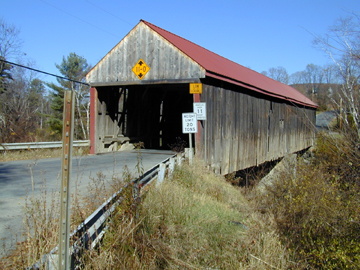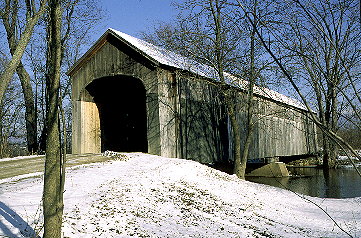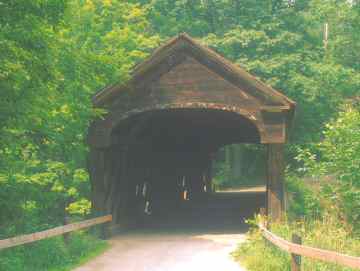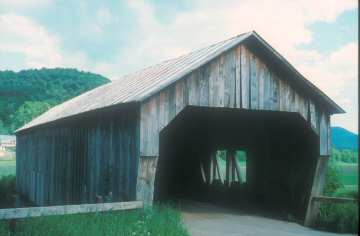
Four Vermont Covered Bridges to Receive Grants
An Update*

July 16, 2003 - The Vermont Department of Transportation proposed projects to the Federal Highway Administration which totaled $2 million, e-mailed Susan Scribner of the VAOT Historic Bridge Program.
The requested funds, provided through the National Covered Bridge Preservation Program authored by Sen. James Jeffords in 1998, will be shared by four of Vermont's covered bridges.
"Apparently," said Scribner, "the $2 million figure requested for federal funds was reduced to $1,987,000 so we will need to make an adjustment of $13,000 to one or more of the covered bridge projects. The project costs that were estimated included all associated costs including engineering, right-of-way acquisition if needed and construction oversight."
The fund allocations are as follows:
| Covered Bridge | Total Estimated Project Cost | Federal Funds Requested | State/Local Funds |
| Salisbury-Cornwall Cedar Swamp | $850,000 | $680,000 | $170,000 |
| Tunbridge Cilley | $400,000 | $320,000 | $80,000 |
| Thetford Sayre | $500,000 | $400,000 | $100,000 |
| Weathersfield Upper Falls | $750,000 | $600,000 | $150,000 |
*The amounts published July 8 by the U.S. Department of Transportation were in error.
The Sayers Bridge [45-09-06] is known for its "Haupt" truss, the only truss of its kind in New England, and one of just three in the United States. The truss used in the span is a unique adaptation of Herman Haupt's 1839 patent. The design, as used here, resembles a multiple kingpost truss. It differs in that it is assembled from planks instead of square timbers and is joined with treenails rather than with mortise and tenon. The builder integrated the whole with a segmented plank arch.
The bridge was restored in 1963 with a mid-span concrete pier and four steel I-beams supporting a new laminated deck. The work was estimated by the VAOT to cost about $30,000 with $6,000 the Town's share. The Town replaced the siding and roof as part of a community project.
Thetford Center's bridge underwent repairs again in 1997 after a dump truck driven by a local resident tried to drive through with its bed raised. He took off two-thirds of the roof.
In November of 2002, a car went through the side of the bridge when the driver lost control inside. The vehicle landed in the Oompompanusuc River upside down. The occupants were rescued by passers-by.
Popularly known as the Tucker Hill Bridge, or as the Sayres Bridge after the furniture mill owned by the Sayres brothers that once operated here, the bridge was listed on National Register of Historic Sites on September 17, 1974 as the Thetford Center Covered Bridge

The midstream pier was added in 1963.
Photo by Joe Nelson, 1997.
The 154-foot Salisbury Station Bridge [45-0101] spans Otter Creek on Swamp Road at the edge of the Great Cedar Swamp. It has been known as the Cedar Swamp Bridge, the Salisbury Station Bridge, or simply as the Station Bridge.
Raised in 1865 by unknown builders, the truss is unique in that the web is wider than that of any other plank-lattice truss in Vermont. It measures four-feet ten-inches on center--the others average about three feet. In 1969 the bridge was renovated and a mid-stream pier added to support the long span. Until then, the Station Bridge was one of the longest single spans in the state. Further work was done in the winter of 1992 when Jan Lewandoski made repairs to the truss.
The casual observer today may wonder why the bridge was built in a remote spot between a large swamp and acres of open fields. In the 1860s, however, it provided the Town of Cornwall with a vital economic link to the Champlain and Connecticut Railway depot at Salisbury.
The bridge, which is Co-owned and maintained by the towns of Cornwall and Salisbury, crosses the town line at Otter Creek.

the Station Bridge was one of the longest single spans in Vermont
Photo by Joe Nelson, 1997
The Upper Falls, or Downers Covered Bridge [45-14-08] was built c1840, the portals finished in the Greek Revival mode. Partial cornice returns and enclosed roof-end overhang bracket the splined gable-end boarding. The treatment simulates the Greek pediments in the Federal architecture popular in the first half of the 1800s. Downers Bridge is Vermont's last example of splined boarding in a bridge portal.
The 121-foot plank-lattice span crosses high over the Black River. The tall stone abutments and long curved wingwalls are the most impressive examples of dry stone masonry in the state. The northern abutment has not been cased in concrete and remains a tribute to the skill of the masons.
The trusses were originally constructed with sway braces, or buttresses, but they are no longer in evidence, dispensed with when the restoration was done by Milton Graton and Sons in 1975.
Neil Daniels, member of the Weathersfield Transportation Advisory Committee and chairman of the Weathersfield Chapter of the Vermont Covered Bridge Society said the bridge has rot in the lower chords not removed in the 1975 rebuild. Instead, a fifth lower chord member was added (a town lattice truss normally uses four chords; upper and lower chords, and upper and lower secondary chords). The south abutment, where the dry laid stone can still be seen, needs attention. The north abutment concrete facing is severely eroded. The exterior of the bridge needs attention, including a new roof.

crosses the Black River near the historic site of Downers Inn.
Photo by Joe Nelson, 1995
The Cilley Bridge [45-09-08] was built in 1883 using the multiple-kingpost truss. The 60-foot bridge spans the First Branch of the White River in Tunbridge, serving Howe Lane. It stands among corn fields in view of Route 110 just south of Tunbridge Village. An old cemetery nearby adds to the ambiance of the site.
The bridge is unique in the construction of the tie-beams and the doubled knee-braces. A new roof, funded by a Federal program, was installed in the late fall, 2002.

tie-beams and the doubled knee-braces
Photo by Joe Nelson, 1993.
